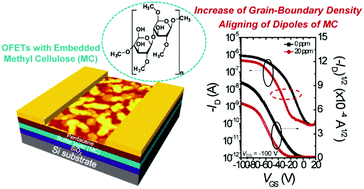Amplifying gas sensor performance by embedding a cellulose-based buffer layer in organic transistors†
Abstract
Real-time detection of gaseous pollutants is of great interest to both environmental monitoring and chemical related health hazard control. Here, we report the drastic effect of a controllable heterointerface between methyl cellulose (MC) buffer layers and pentacene on the performance of organic field-effect transistor (OFET)-based gas sensors. Compared with pristine pentacene films, fabricated pentacene films with underlying MC layers, which alter the growth of pentacene and introduce structural trapping effects, improve the gas responsivity with a detection limit for NO2 as low as 1 ppm. The underlying MC multiplies the number of chemically active grain boundaries of pentacene according to morphological evaluation and impedance spectroscopy. The sensitivity of the sensors is further amplified by dipole aligning of hydroxyl-terminated MC. Our findings suggest that cellulosic materials, which simultaneously enable sophisticated control over the growth of organic thin films and electrostatic interaction of gas molecules, are considered to be excellent candidates as the buffer layer for low-cost and high-performance OFET-based gas sensors.



 Please wait while we load your content...
Please wait while we load your content...